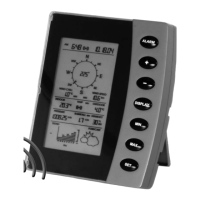
Do you have a question about the Thermor Home Weather Station and is the answer not in the manual?
| Outdoor Temperature Range | -20°C to +60°C |
|---|---|
| Humidity Range | 20% to 95% |
| Display | LCD |
| Indoor Temperature Range | 0°C to 50°C |
| Temperature Accuracy | +/- 1°C |
| Humidity Accuracy | +/- 5% |
| Transmission Range | Up to 100 meters |
Lists the components included for the Home Monitor unit and its power adapter.
Lists the components for the Thermometer & Transmitter Sensor, including mounting hardware.
Lists the components for the Wind Sensor, including mast mounting hardware.
Lists the components for the Rain Sensor, including mounting screws.
Guides on placing and mounting the Home Monitor, considering factors like sunlight, drafts, and interference.
Instructions for mounting the wind sensor vertically on a mast, including cable preparation and securing the unit.
Instructions for mounting the wind sensor horizontally on a mast or antenna pole, ensuring correct north orientation.
Details how to mount the rain sensor on a flat, horizontal surface for accurate measurements.
Provides guidance on mounting the thermometer-transmitter sensor on a wall or flat surface.
Describes how to connect the cables from the outdoor sensors to the thermometer-transmitter.
Step-by-step guide to powering up the Home Weather Station for the first time using AC adapter or batteries.
Instructions for replacing the batteries in the outdoor transmitter unit.
Addresses issues where the main unit's LCD screen displays nothing, indicating a power problem.
Troubleshoots missing outdoor data, usually due to interference or low transmitter battery power.
Addresses issues where wind speed and direction data are not displayed, pointing to transmission problems.
Troubleshoots missing outdoor temperature readings, often caused by interference or low battery.
Explains that a static wind speed reading typically indicates dead transmitter batteries.
Solves problems with outdoor readings ceasing after a period, often due to battery life or interference.
Addresses issues with inaccurate wind direction readings, possibly due to pole material or interference.
Solves cases where wind direction remains constant, possibly due to freezing rain or interference.
Explains pressure variations due to voltage changes and sensor adjustment.
Troubleshoots limited transmission range, suggesting interference or distance issues.
Addresses persistent lack of outdoor readings even after resetting, indicating potential interference or defective transmitter.
Troubleshoots excessively high wind speed readings, often caused by transmission issues or interference.
Addresses low wind speed readings, which can be due to average gust calculations or obstructions.
Explains factors affecting wind speed accuracy, including obstructions, interference, and non-real-time data.
Explains that the trend chart requires 24 hours of pressure data to display.
Explains that forecast icons need time and pressure data to become accurate after initial setup.
Discusses the limitations of the weather forecasting feature compared to professional systems.
Reiterate the recommended viewing angle for the LCD screen for optimal clarity.
Details battery life expectations and factors affecting it, suggesting power adapter use in cold.